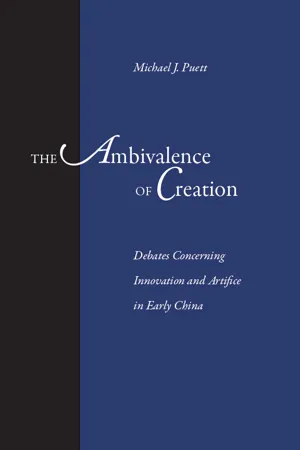
The Ambivalence of Creation
Debates Concerning Innovation and Artifice in Early China
- 312 pages
- English
- ePUB (mobile friendly)
- Available on iOS & Android
The Ambivalence of Creation
Debates Concerning Innovation and Artifice in Early China
About This Book
As early as the Warring States period in China (fourth through third centuries B.C.), debates arose concerning how and under what circumstances new institutions could be formed and legitimated. But the debates quickly encompassed more than just legitimation. Larger issues came to the fore: Can a sage innovate? If so, under what conditions? Where did human culture originally come from? Was it created by human sages? Is it therefore an artificial fabrication, or was it based in part on natural patterns? Is it possible for new sages to emerge who could create something better?
This book studies these debates from the Warring States period to the early Han (second century b.c. ), analyzing the texts in detail and tracing the historical consequences of the various positions that emerged. It also examines the time's conflicting narratives about the origin of the state and how these narratives and ideas were manipulated for ideological purposes during the formation of the first empires.
While tracing debates over the question of innovation in early China, the author engages such questions as the prevailing notions concerning artifice and creation. This is of special importance because early China is often described as a civilization that assumed continuity between nature and culture, and hence had no notion of culture as a fabrication, no notion that the sages did anything other than imitate the natural world. The author concludes that such views were not assumptions at all. The ideas that human culture is merely part of the natural world, and that true sages never created anything but instead replicated natural patterns arose at a certain moment, then came to prominence only at the end of a lengthy debate.
Frequently asked questions
Information
Table of contents
- Title Page
- Copyright Page
- Dedication
- Acknowledgments
- Table of Contents
- Introduction
- CHAPTER I - Domesticating the Landscape: Notions of Ancestors and Innovation in the Bronze Age
- CHAPTER 2 - The Craft of Humanity: Debates over Nature and Culture in Warring States China
- CHAPTER 3 - Sages, Ministers, and Rebels: Narratives of the Emergence of the State
- CHAPTER 4 - The Creation of Empire: The Emergence and Consolidation of Imperial Rule in China
- CHAPTER 5 - The Tragedy of Creation: Sima Qian’s Reconstruction of the Rise of Empire in Early China
- Reference Matter
- APPENDIX - The Semantics of Creation
- Notes
- Bibliography
- Index